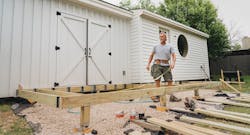The Talent Builders
The recent boom in home sales belies a pair of severe and related shortages: one of supply, the other of labor. Two organizations, Building Talent Foundation (BTF) and M.T. Copeland, both only a couple of years old, want to help fill the construction talent gap.
BTF connects job seekers with employers in residential construction. M.T. Copeland produces video training courses to develop construction and business skills.
Now, the organizations have joined forces. By collaborating together, they intend to help job seekers access online training while helping online learners access job opportunities.
There should be plenty of opportunities waiting for them: the construction industry needs 2.2 million more workers by 2024, according to NAHB’s Home Builders Institute.
M.T. COPELAND COURSES
Launched in 2020, M.T. Copeland creates high-quality online instruction courses taught by construction professionals and experts. The topics range from how to read blueprints to how house framing works to how to succeed on the job. Each course lasts about two to four hours—broken up into 5-to-20-minute lessons so people can watch them at their own pace.
With almost 30 courses now available and plans to offer about 40 in the next couple of months, M.T. Copeland charges $75 per course or $225 for longer or bundled courses. Once purchased, the training sessions can be accessed indefinitely.
The similarity to MasterClass isn’t coincidental. M.T. Copeland cofounder Michael Dearing helped launch MasterClass, whose online classes feature experts and often famous figures teaching a wide range of fields. Gabe Jewell, M.T. Copeland cofounder and CEO, spent several years as a MasterClass producer.
“We understood there’s not only a shortage of skilled labor but also a shortage of accessible, high-quality training,” Jewell says of the initial impetus behind M.T. Copeland, based in the Bay Area and named after an educator who promoted trade training paired with business knowledge.
“They’re both inspiring and informative,” Branka Minic, BTF’s CEO, says of M.T. Copeland’s courses. “When you watch them, you can see yourself in these roles.”
M.T. Copeland’s clients aren’t just individual learners. Builders, remodelers, and contractors have had their employees take the online courses and paid for them.
THE BRAINS BEHIND BUILDING TALENT FOUNDATION
Builders, of course, understand the worker shortage all too well. That’s why, in 2019, 20 of the nation’s largest homebuilders—including D.R. Horton, Lennar, and Pulte—came together to form a workforce development agency, BTF. The nonprofit aims to get more people into residential construction careers and also to help align training programs with the skills that builders need.
BTF doesn’t train job seekers itself but instead connects them with employment opportunities, many with its founders’ partners, including contractors, suppliers, and manufacturers. In addition, BTF hosts JobsToBuild.com, a no-cost construction careers platform that serves both job hunters and hirers.
Last year, BTF’s first full year of operations, it helped place over 430 people. This year, it will have about 10,000 job seekers in its pipeline. BTF has focused so far on 10 markets (in Arizona, Florida, Tennessee, and Texas) but plans to expand to 15 more locations this year (in California, Colorado, Georgia, and North Carolina).
“We want to build the workforce for the future,” Minic says.
APPEAL TO ALL, SOLVE THE SHORTAGE
Minic also wants the industry to stop talking about the “labor shortage” and instead speak of the “talent shortage.”
“We have to change some of the misconceptions about careers in construction so that young people can see it as a viable option,” she says. “It’s not all about hard labor.” The industry, she adds, should convey its need for a variety of skills, including technological, and its appeal to a variety of people, including women.
One BTF client, Minic recalls, was a high school student who worked as a part-time dog walker. But he dreamed of going to college to get his electrical engineering degree. Through BTF’s help, he landed a job as an electrical technician so he could earn an income, attend college, and learn his craft at the same time.
It’s through partnerships like the one between BTF and M.T. Copeland that many more people will find their way to construction careers, Minic says. “This industry will benefit from people working together, not staying in their corners.”
Take a look at what their courses have to offer:

